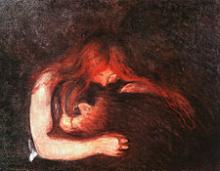For one thing, there isn't really a clear distinction between a witch, a werewolf and a vampire in Romanian lore- they're all basically just types of strigoi. If a strigoi is dead, it's a “strigoi mort” or what we would call a vampire. If it's alive, it's a “strigoi viu,” which is like a “wicked witch” except that it's also vampiric. If it takes the shape of a wolf, as strigoi can, it might also be seen as a “pricolici” or vampire/werewolf.
All of these different types of strigoi feed on the life energy of living humans, usually (but not always) in the form of blood. “Strigoi mort,” though- the true undead vampires- don't look anything like Lestat or that kid from Twilight.
What do they look like? Dead people, of course- corpses. That is what they are, after all. A strigoi mort is a dead corpse that can unnaturally prolong its existence by drinking human blood, most often that of its own family. It's almost closer to a zombie than a Hollywood vampire.
If you ever happen to run into one, don't just jab a stake through its chest and expect it to collapse into dust like on “Buffy the Vampire Slayer.” That won't work on a strigoi mort. The stake is actually just to pin the vampire down so you can safely cut its head off and then burn it in a bonfire. Without a very thorough bonfire, that strigoi mort is just going to keep on coming back! In fact, according to Romanian folklore, if the vampire can escape this fate for seven years it can come most of the way back to life and even have children, although all of them are doomed to become strigoi in the end.
